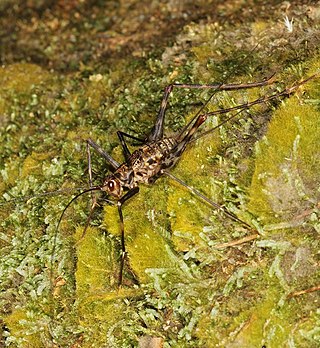
Orthoptera is an order of insects that comprises the grasshoppers, locusts, and crickets, including closely related insects, such as the bush crickets or katydids and wētā. The order is subdivided into two suborders: Caelifera – grasshoppers, locusts, and close relatives; and Ensifera – crickets and close relatives.

Anostostomatidae is a family of insects in the order Orthoptera, widely distributed in the southern hemisphere. It is named Mimnermidae or Henicidae in some taxonomies, and common names include king crickets in Australia and South Africa, and wētā in New Zealand. Prominent members include the Parktown prawn of South Africa, and the giant wētā of New Zealand. The distribution of this family reflects a common ancestry before the fragmenting of Gondwana.

The orthopteran family Rhaphidophoridae of the suborder Ensifera has a worldwide distribution. Common names for these insects include jumping wētā, cave wētā, cave crickets, camelback crickets, camel crickets, Hogan bugs, spider crickets ,land shrimp, and sand treaders. Those occurring in New Zealand and Australia are typically referred to as jumping or cave wētā. Most are found in forest environments or within caves, animal burrows, cellars, under stones, or in wood or similar environments. All species are flightless and nocturnal, usually with long antennae and legs. More than 500 species of Rhaphidophoridae are described.

The conservation status of a group of organisms indicates whether the group still exists and how likely the group is to become extinct in the near future. Many factors are taken into account when assessing conservation status: not simply the number of individuals remaining, but the overall increase or decrease in the population over time, breeding success rates, and known threats. Various systems of conservation status exist and are in use at international, multi-country, national and local levels as well as for consumer use.

The Khajuria's leaf-nosed bat, also known as Durga Das's leaf-nosed bat, is a species of bat in the family Hipposideridae. It is endemic to India. Its natural habitat is caves. It is threatened by habitat loss.
Cyanea dolichopoda was a species of shrub in the bellflower family that was endemic to Kauai. It was discovered in 1990 and has not been located in the wild since 1992. Like other Cyanea it is known as haha in Hawaiian.

The Mahé boulder cricket is an insect species endemic to Mahé island in Seychelles. This species of cricket is only found in two localities, the Morne Seychellois National Park and "La Reserve". The species had not been recorded since 1909, until its rediscovery in 2014. It is a restricted range species, with an area of occupancy less than 10 square kilometres (3.9 sq mi) and with a very fragmented population.

Dolichopoda is a genus of cave crickets in the tribe Dolichopodaini, subfamily Dolichopodainae. They are distributed in the Mediterranean basin in southern Europe and western Asia.
Hipposideros alongensis, known as the Ha Long leaf-nosed bat, is a species of bat in the family Hipposideridae. It is endemic to Vietnam. It is listed as a vulnerable species by the IUCN.

The Malaysian whiskered myotis or Malayan whiskered myotis is a species of vesper bat endemic to Malaysia, although it may possibly also occur in Indonesia.

The Tooth Cave pseudoscorpion(Tartarocreagris texana) is a small cave-dwelling arachnid of the family Neobisiidae. The species was originally assigned to the genus Microcreagris, and then reassigned to Austalillocregris before arriving at its current genus, Tartarocreagris. The Tooth Cave pseudoscorpion has a small geographic distribution, known to occur in only two caves in Travis County, Texas. Additionally, it is tentatively identified in two nearby caves in Texas, but more research is necessary to accurately define the range where the species lives. There is little known about the biology, life cycle, and life history of the Tooth Cave pseudoscorpion due to a lack of research and study. Because of this, the Tooth Cave pseudoscorpion is listed on the IUCN Red List as data deficient. Under the Endangered Species Act, the Tooth Cave pseudoscorpion is listed as endangered. Recovery plans for the species focus mostly on preserving the karst ecosystem that the pseudoscorpions live in, especially including lessening human impacts on the environment.

Dolichopoda azami, the Azam's cave-cricket, is a species of cave cricket within the family Rhaphidophoridae. The species distribution is in France in the Southern Alps and in Italy in Piedmont, Liguria and Lombardia, where it lives in various dark habitats that have stable tempuratures and high humidity. Such habitats include rocky forests, caves, damaged bridges or aqueducts, and abandoned/disused buildings at elevations of 120 to 1,940 metres. It lives in these habitats during the day and is primarily active at night.
Monocentris reedi is a species of ray-finned fish within the family Monocentridae. The species is found in the southeastern Pacific near Chile off the Juan Fernández Islands, Nazca Ridge and the Desventuradas Islands, where it lives a demersal lifestyle inhabiting tide pools, caves, and deep rocky reefs at depths of 10 to 250 meters. It grows to lengths of 9.2 to 9.9 centimeters.
Dolichopoda lycia is a species of cave cricket within the family Rhaphidophoridae. The species is found around caves around Antalya, Turkey.










